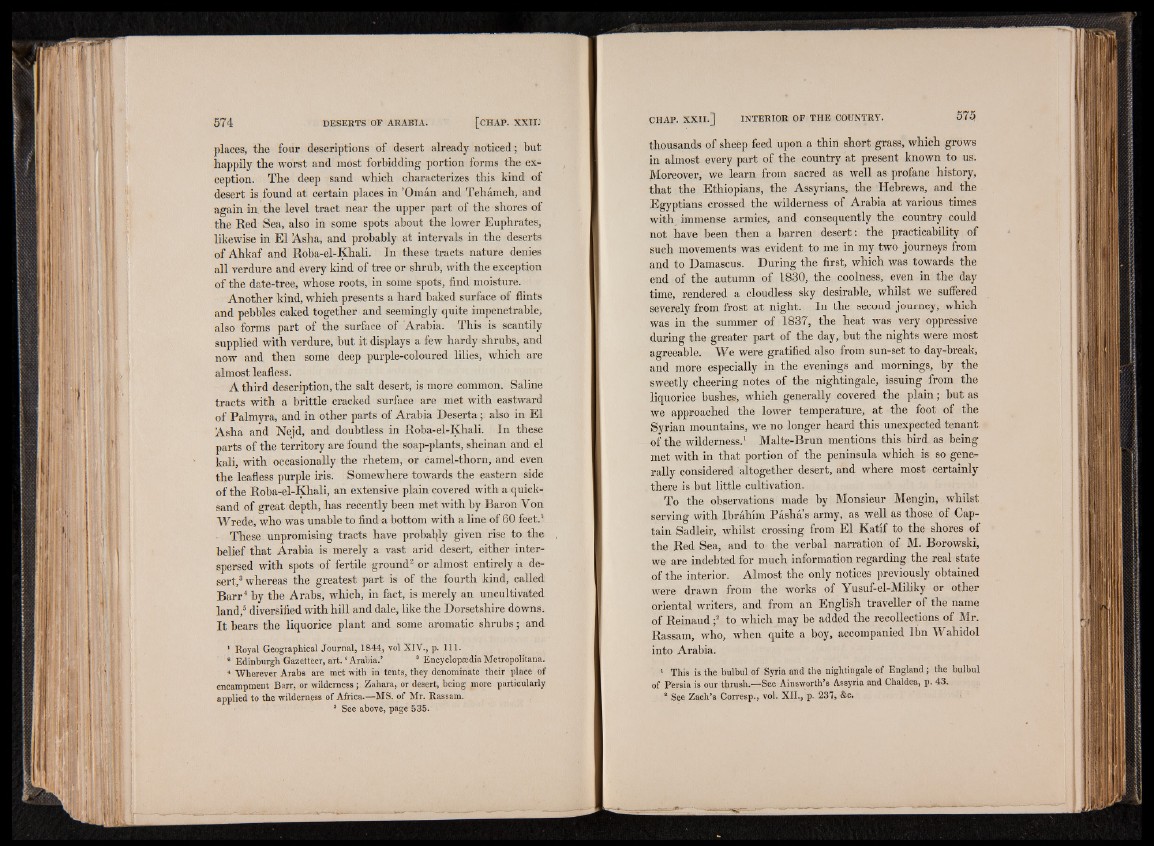
places, the four descriptions of desert already noticed; but
happily the worst and most forbidding portion forms the exception.
The deep sand which characterizes this kind of
desert is found at certain places in ’Omán and Tehámeh, and
again in. the level tract near the upper part of the shores of
the Red Sea, also in some spots about the lower Euphrates,
likewise in El Asha, and probably at intervals in the deserts
of Ahkaf and Roba-el-Khali. In these tracts nature denies
all verdure and every kind of tree or shrub, with the exception
of the date-tree, whose roots, in some spots, find moisture.
Another kind, which presents a hard baked surface oí flints
and pebbles caked together and seemingly quite impenetrable,
also forms part of the surface of Arabia. This is scantily
supplied with verdure, but it displays a few hardy shrubs, and
now and then some deep purple-coloured lilies, which are
almost leafless.
A third description, the salt desert, is more common. Saline
tracts with a brittle cracked surface are met with eastward
of Palmyra, and in other parts of Arabia Deserta; also in El
Asha and Nejd, and doubtless in Roba-el-Khali. In these
parts of the territory are found the soap-plants, sheinan and el
kali, with occasionally the rhetem, or camel-thorn, and even
the leafless purple iris. Somewhere towards the eastern side
of the Roba-el-Khali, an extensive plain covered with a quicksand
of great depth, has recently been met with by Baron Von
Wrede, who was unable to find a bottom with a line of 60 feet.1
These unpromising tracts have probably given rise to the
belief that Arabia is merely a vast arid desert, either interspersed
with spots of fertile ground2 or almost entirely a desert,
3 whereas the greatest part is of the fourth kind, called
Barr4 by the Arabs, which, in fact, is merely an uncultivated
land,5 diversified with hill and dale, like the Dorsetshire downs.
It bears the liquorice plant and some aromatic shrubs; and
1 Royal Geographical Journal, 1844, vol XIV., p. 111.
e Edinburgh Gazetteer, art. ‘ Arabia.’ 8 Encyclopaedia Metropolitana.
* Wherever Arabs are met with in tents, they denominate their place of
encampment Barr, or wilderness; Zahara, or desert, being more particularly
applied to the wilderness of Africa.—MS. of Mr. Rassam.
5 See above, page 535.
thousands of sheep feed upon a thin short grass, which grows
in almost every part of the country at present known to us.
Moreover, we learn from sacred as well as profane history,
that the Ethiopians, the Assyrians, the Hebrews, and the
Egyptians crossed the wilderness of Arabia at various times
with immense armies,. and consequently the country could
not have been then a barren desert: the practicability of
such movements was evident to me in my two journeys from
and to Damascus. During the first, which was towards the
end of the autumn of 1830, the coolness, even in the day
time, rendered a cloudless sky desirable, whilst we suffered
severely from frost at night. In the second journey, which
was in the summer of 1837, the heat was very oppressive
during the greater part of the day, but the nights were most
agreeable. We were gratified also from sun-set to day-break,
and more especially in the evenings and mornings, by the
sweetly cheering notes of the nightingale, issuing from the
liquorice bushes, which generally covered the plain; but as
we approached the lower temperature, at the foot of the
Syrian mountains, we no longer heard this unexpected tenant
of the wilderness,1 Malte-Brun mentions this bird as being
met with in that portion of the peninsula which is so generally
considered altogether desert, and where most certainly
there is but little cultivation.
To the observations made by Monsieur Mengin, whilst
serving with Ibrahim Pasha s army, as well as those of Captain
Sadleir, whilst crossing from El Katif to the shores of
the Red Sea, and to the verbal narration of M. Borowski,
we are indebted for much information regarding the real state
of the interior. Almost the only notices previously obtained
were drawn from the works of Yusuf-el-Miliky or other
oriental writers, and from an English traveller of the name
of Reinaud ;2 to which may be added the recollections of Mr.
Rassam, who, when quite a boy, accompanied Ibn Wahidol
into Arabia.
1 This is the bulbul of Syria and the nightingale of England; the bulbul
of Persia is our thrush.—See Ainsworth’s Assyria and Chaldea, p. 43.
s See Zach’s Corresp., vol. XII., p. 231, &c.